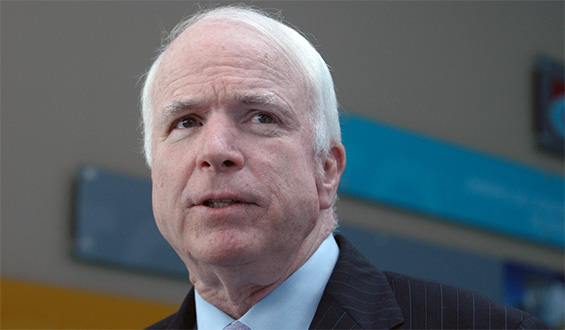 (Photo: Jim Greenhill, Creative Commons)
(Photo: Jim Greenhill, Creative Commons)
US Sen. John McCain has explained that he is tired of watching the Bureau of Indian Education (BIE) fail over and over again, and now the Senator is taking action by introducing a bill that would allow Native American young people to have additional school choices.
Sen. McCain (R-Arizona) has initiated the Native American Education Opportunity Act (S 2711), a bill that aims to take money out of the coffers of the BIE and allow native children to create “education funds” to use for attending the schools of their choice. The funds could be used for private school tuition, books, tutors, and other education-centered expenses.
His measure would take 90% of the funding that the BIE would have been given based on having the student enrolled in their schools and put it in a designated savings account.
But the Navajo Nation Department of Diné (the Navajos’ preferred name, meaning “The People”) Education Superintendent Tommy Lewis thinks S 2711 is extremely improvident. He believes the bill would not address the central issues faced by Navajo students.
“How native tribes could participate is yet to be known. Transportation to a private school – many miles away off the reservation – would pose a problem for many tribal families,” Lewis said.
The National Indian Education Association was also not impressed by McCain’s bill. “Interesting,” was the response from NIEA Executive Director Ahniwake Rose. She added that factors such as maintenance and construction that BIE schools face could only be addressed by adequate funding.
McCain’s reply was that the bill would only allow students to attend a different school, but it would not force students to do so.
Because federal officials have not conducted regular maintenance inspections, dozens of Native American schools are plagued by exposed electrical wires, broken windows, and even natural gas leaks.
Almost 200 schools in 20 states, serving 47,000 Native American students, are overseen by the Interior Department’s Bureau of Indian Education, which received $138 million in funding this year to bring buildings and classrooms up to code and to replace those that could not be restored. The schools are, for the most part, on rural reservations.
“Indian Affairs cannot ensure that the learning and work environments at BIE schools are safe, and it risks causing harm to the very children that it is charged with educating and protecting,” a congressional watchdog said.
Even as repairs are taking place, deterioration could continue if schools do not receive annual inspections and have repair plans ready, reports the Associated Press.
The Interior Department is asking for $1 billion to make classroom improvements, bolster technology, and create Native American cultural programs for students.
California’s Elk Grove Unified School District’s Indian Education program is widely recognized as one of the best and most innovative programs for Native American students. The programs include tutoring assistance, outreach to parents of at-risk students, and Native American cultural classes during the school day, after school, and during the summer.
The funding for these programs does not come from federal grant Title VII services, so support has come from Local Control Funding and community partnerships. Families are encouraged to use the programs, and program officials find collaborative methods to serve them, reports the Elk Grove Citizen.
An online release stated that the Native American Education Opportunity Act would provide customized education options for students who live on reservations. Funding would be taken from BIE by way of per-pupil funding at a rate of 90%. BIE schools would retain 10% of funds not granted to the student. The competition between BIE schools and private schools, according to McCain, would work toward making both school systems better.




